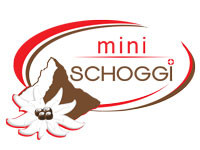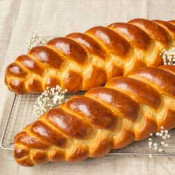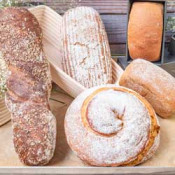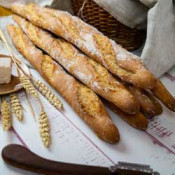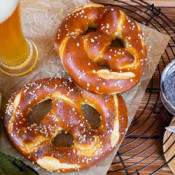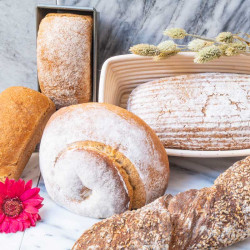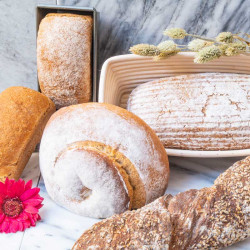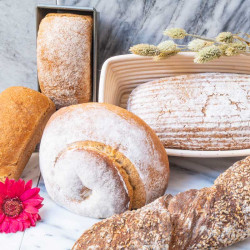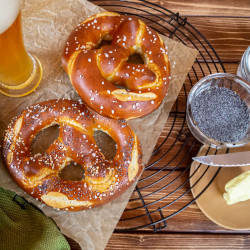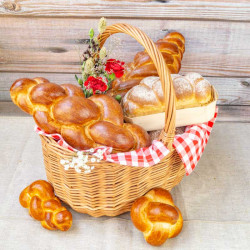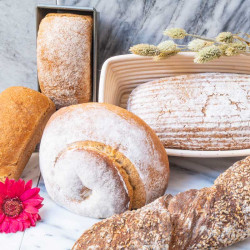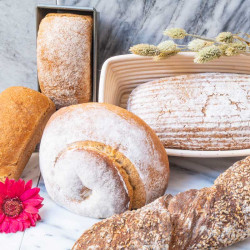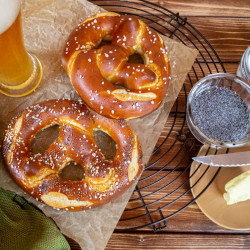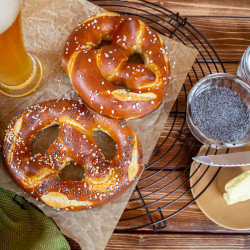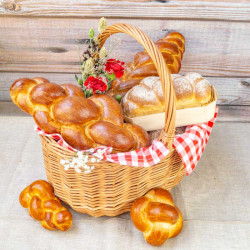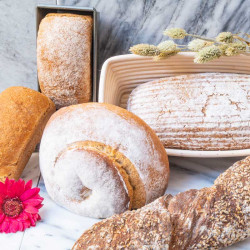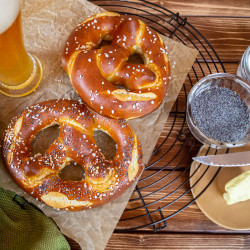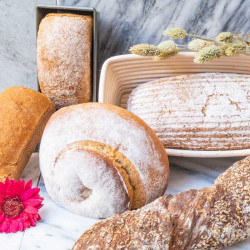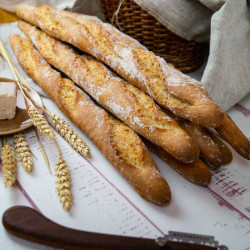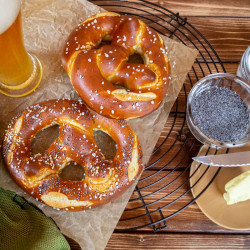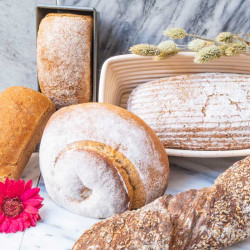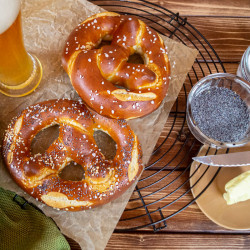Bread courses
Unterkategorien
Bread courses
Flour, water and yeast - these are the basic ingredients of one of the most versatile pastries ever. With small adjustments to the quantities, the addition of butter, milk, egg or salt and the skillful kneading, shaping and baking of the dough, an incredible variety of bread is created. With sweet jam for breakfast, with a warm soup or a crunchy salad to go with it, or combined with sausage and cheese for dinner - bread fits always and everywhere.
The recipes and possible combinations are almost unlimited, so it's all the nicer that bread can also be made quite easily at home. In many Swiss kitchens, delicious, fresh bread is baked regularly and even the Sunday plait often comes from your own oven. If you don't have any experience with baking your own bread or if you want to learn how to make a perfect sourdough or baguette, you've come to the right place.
Welcome to miniSchoggi
In our specially equipped bakery, a professional baker will show you what is important for the perfect plait, baguette or sourdough. With a lot of expertise and professional experience, our course leader will help you make various delicious pastries and understand the processes behind them.
For example, you will be introduced to the production of sourdough, which creates particularly aromatic and long-lasting breads. Braiding and the shaping of braided animals and filled brioches also find a place in our courses. For fans of French bakery, there is a baguette course, and for those who prefer to handle and experiment with different types of flour, our special bread course is ideal. In the miniSchoggi bakery there is something for everyone.
Sourdough course
A successful sourdough gives the bread a longer shelf life and a wonderful variety of flavors. At our sourdough beginners' course, you will learn how to prepare, raise, maintain and finally bake sourdough. You can also try your hand at making your own sourdough. Our baker will equip you with all the necessary knowledge to keep the sourdough alive and to use it for different types of bread. At the end of the course, in addition to your own sourdough starter and all the recipes and instructions, you will also take home a wheat sourdough bread and a rye sourdough bread that you have formed and baked, with an incomparable aroma.
More detailed information about the course can be found in the corresponding subcategory.
Baguette & Brioche Course
If you are addicted to French bakery, this course is for you. Crispy baguettes are popular all over the world and can also be baked quite easily in your own kitchen. Our baker will show you how to make delicious baguettes from yeast, water, salt and flour. In addition, various brioches will also be made. The small rolls come in all kinds of varieties - as a simple roll and filled with salt or sweet. You will learn at the course how to shape them perfectly and how to guarantee that nothing leaks out, and you will be able to apply your new knowledge right away. You will fill and shape your own brioches and bake real baguettes from wheat and spelt flour together with the professional course instructor. Together with the fresh pastries and a lot of new knowledge, you will also take home all the recipes and instructions from the course.
More detailed information about the course can be found in the corresponding subcategory.
Special bread course
If you want to learn to work with different flours, with yeast as well as sourdough and with different shaping techniques, the special bread course is the perfect choice. From this course you will take home knowledge about a wide variety of breads and many tips and tricks from a professional baker. At the course you will shape and bake your own rye sourdough bread, a crispy root bread in a grain casing, a delicious original spelt bread and a healthy wholemeal bread.
Your creations will be freshly packaged right at the end of the course and you will receive all the recipes and instructions for your own kitchen. So you have a good basis for the production of various different types of dough and bread.
More detailed information about the course can be found in the corresponding subcategory.
Pigtail course
The Zopf is one of the most popular breads in Switzerland and incredibly versatile. On the one hand, it can be made with different flours and combined with different ingredients, on the other hand, it is perfect for forming various figures and shaped pastries. At the course, you will learn different braiding methods and what needs to be considered for the perfect braided dough. In addition to the recipes and instructions for various shapes, you will also take home a part of a five-strand plait, a self-braided butter plait, your own original spelt plait and various small pastries. This way, the next Sunday braid will turn out perfectly and nothing will stand in the way of a lavish brunch.
More detailed information about the course can be found in the corresponding subcategory.
Swiss bread variety
An incredible number of pastries are created from just a few ingredients. In Switzerland and Germany, hundreds of different types of bread are baked and sold. We are all the more surprised when we are on vacation in a foreign country and stand in the store and look in vain for "normal" bread. While there are still baguettes in France and various flatbreads in eastern countries, in many other regions only toast is available - in terms of taste and consistency, there is no comparison with crusty mixed bread, fresh from the oven. So let's enjoy the bread variety and once again remind ourselves what Switzerland has to offer in terms of specialties!
Farmhouse bread
Let's start right away with a bread that is as well-known as it is delicious. The farmer's bread is very popular throughout Switzerland and also looks appealing with the grid pattern of floured squares on the crust. Contrary to the name, however, the fine-pored pastry was rather not part of the usual peasant meal. Swiss bakers developed this recipe to relieve some of the milk surplus on Swiss farms. In addition to its elegant appearance, fine-split crust and fine pores, the milk in the dough is probably the most important characteristic of a true farmer's bread.
St. Gallen bread
Also known as Appenzeller, Thurgau or simply Eastern Swiss bread, this pastry is especially well known and popular in German-speaking Switzerland. The airy half-white or Ruchmehlbrot has a particularly crispy crust and captivates with a variety of flavors.
From the shape it is easy to see that this bread has also been baked for a long time by the peasant families themselves. Indeed, the traditional round and high shape provides little surface that could dry out. If in the past bread was baked only once a week, a round bread in the middle still remained fresh for a long time. The sourdough used also promoted the preservation of freshness. Since the 19th century, when yeast was invented, the sourdough was often replaced or supplemented to reduce the rising time. St. Gallen bread owes its status as a cantonal bread to Swiss bakers. As a marketing strategy, they sold various cantonal breads, many of which are barely known today. Moreover, the many names of St. Gallen bread clearly indicate that this pastry was baked in other parts of eastern Switzerland and not only in the canton that officially gave it its name.
Long bread
Another cantonal bread is the long, stick or Zurich cantonal bread. Here, too, the naming is the result of a marketing strategy, but eventually other names have prevailed. In the past, the long bread was mainly a Sunday bread - due to its elongated shape it dries out faster and was therefore a treat to be enjoyed fresh - but today it is one of the best-selling breads in Switzerland. However, a large part of the bread does not go to private households, but is sold to inns. There, the even, long shape is appreciated because it allows a particularly large number of slices of bread of the same size to be cut. So if you order a soup or a salad, there is a good chance that you will get a slice of this Ruch or half-white flour bread to go with it.
Basel bread
Basel bread is also very popular, but rather not suitable for inns. Because this pastry is known for its large and often rather irregular pore. This is created by a very high baking temperature, and in addition the dough pieces are only coarsely shaped and no longer kneaded, which preserves the loose dough structure. In addition, the crust is dark, crispy and floured. With about 80% water in relation to the flour, this is a very moist bread. This pleasant characteristic has made Basel bread famous throughout Switzerland - including in French-speaking Switzerland and Ticino - as well as in cities near the borders of, for example, Germany.
Valais rye bread
Another successful cantonal bread is the traditional Valais rye bread. Wheat used to be difficult to grow, but rye enjoyed our humid climate. As a result, these breads were baked by Swiss families as early as the 1500s. With its many nutrients and the variety of flavors, this bread is a real treat today, but in the past it was considered a poor man's bread. In the villages of Valais, the village oven was fired up only two to four times a year. On this occasion, families from smaller villages that did not have an oven would also come. One after the other, each family baked all the bread for the next quarter of the year. Towards the end of this period, the rye bread often had to be cut with an axe and soaked in soup in order to be eaten at all. Today, of course, the rye bread is best enjoyed fresh, so it tastes best.
Türggen bread
Contrary to its name, this bread does not have Turkish roots or any other corresponding naming context. In fact, the typical bread of the Rhine Valley owes its name to a special ingredient. Türggen or Törrga is the corn grown in the Rhine Valley of St. Gallen. In contrast to most Swiss corn, this is not cattle feed, but a specialty that is processed into the traditional Rheintaler Ribelmais and flour. Thus, it was the food basis of the local population from early on. Today, corn bread is sold both in the area of origin and in many bakeries throughout Switzerland. Raisins are often added to the combination of corn and semi-white flour, water and a Ruchmehl sourdough. This gives the bread a subtle sweetness and it tastes great even without a spread.
Ticino bread
One cantonal bread that has clearly succeeded in crossing language barriers is Ticino bread. The soft white or semi-white flour dough is formed into a cuboid which, once baked, can be torn into about ten small rolls with the help of the notches. This is also a bread with tradition, but in the past it was reserved for the upper class because of the light flour. Moreover, it was produced and sold only in bakeries, it was not baked at home.
Panettone
From Milan via Italian-speaking Switzerland, the panettone also found its way to local bakeries. Although the sweet panettone, with its many candied fruits and nuts, is often enjoyed for dessert and is also considered a cake, the name comes from bread and for good reason. The cake is baked with a wheat sourdough and thus carries a piece of bread in it. It is also characterized by its very long shelf life and is especially popular to eat and give away at Christmas time. Its production is rather laborious and you should always allow enough time. After baking in the typical paper baking pan, the panettone is turned upside down with a panettone turner. This prevents the airy cake bread from collapsing after baking. The Panettone is still today a festive pastry, which is enjoyed especially at Christmas time.
Epiphany cake
Christmas is soon followed by Epiphany and with it one of the most widespread customs in Switzerland. In bakeries and private homes, Epiphany cakes are baked with raisins or chocolate and, of course, a small king figure. For this purpose, the yeast dough is formed into a large central ball and some smaller balls for all around. Surprisingly, the custom in this form has only existed since 1952. From traditions of a similar custom, this form was developed and actively spread in Switzerland - with success!
Weggli
Mutschli, Milchbrötchen, pain au lait or Schwöbli - the Weggli goes by many names. In the 16th century, the Weggli first appeared in a legal ruling. Normal bakers were forbidden to produce the Weggli, only so-called white bakers were allowed to produce luxury pastries with such light flour. Nevertheless, the bread roll baked with milk and butter spread and is still enjoyed today as a special treat, for example with a Schoggistängeli or with salad, cheese and meat as a sandwich. In addition to the typical round shape with the furrow in the middle, slightly larger, elongated rolls with spiky incisions are also baked from the same dough. These are called Murren or, when distributed to students in eastern Switzerland at the end of the semester, Examenweggen.
Grittibänz
Another pastry with many names is the Grittibänz. Depending on the place, it is called Elggermaa, Bonhomme or even Chlaus. Even before the 19th century, these yeast dough figures were baked in German-speaking Switzerland, and in the 20th century the pre-Christmas tradition was carried throughout Switzerland by various large-scale distributors. Today, the Grittibänz, made of neutral or sweet dough, can be bought in almost all Swiss bakeries from mid-November to the end of December.
Pigtail
At the Sunntigszmorgen or the brunch one thing must never be missing: Zopf. The pastry, which probably originated in Bern, has been around since at least the 15th century - a long success story. In addition to its rich taste, Zopf also scores with its attractive appearance. There are countless ways to braid Zopfteig or to form figures. People also like to experiment with other ingredients. Today there are Zopf recipes with white, spelt or wholemeal flour, refined with bacon, chocolate or cinnamon, from one, two or even five strands. With the "Züpfe" you can create a suitable pastry for any occasion.
History of bread
Today, Switzerland is home to a wide variety of delicious breads and cookies, but it was a long way to get to these tasty treats.
Nomads who followed the animals in the territories of Asia and Europe, already knew some nutritious plants. Besides ancestors of fruit trees and vegetable plants, they also harvested grain. Its grains could be nibbled or processed immediately. When crushed and mixed with water, a porridge was formed, which in turn could be poured onto a hot stone, where it solidified into a flat pancake. Within a few hours, this became hard and was probably not a particular pleasure, but it allowed a longer storage and was an optimal travel food for nomads.
The nomads harvested the plants when they passed by their growing area and also started to sow more of them. In this way, they ensured a higher yield the next time they visited the area. With sedentarization came agriculture and people perfected sowing and harvesting, coordinating sowing, tending and harvesting with the seasons. At that time, einkorn and emmer - two lower-yielding precursors of wheat - were cultivated.
To be able to bake better flatbreads, the first oven was invented about 6000 years ago. This was still very simple, only a pot was placed over the bread flat, so the hot air remained enclosed and the dough was baked more evenly. The Egyptians improved the oven and also contributed much more to the development of bread. They were the ones who probably baked an airy bread for the first time. If the mixed cereal porridge is left to stand, yeast and lactic acid bacteria multiply in it. Their metabolic processes produce carbon dioxide, which, enclosed in the bread dough, helps to loosen it. The so-called fermentation did not always work out equally well, but the Egyptians quickly discovered that a new dough could be mixed with a little well-fermented dough and again obtain a delicious, airy dough - the sourdough was invented.
The breads, now no longer just flat, were baked in large beehive-like ovens and distributed to the population. Very finely ground and sifted flour was reserved for the pharaoh and the ruling class.
From the Egyptians, who, by the way, are also called "bread eaters" because of the more than 30 types of bread they produced, bread reached Greece, where it was enjoyed with honey and wine. The Romans saw off this interesting new food and soon built huge mills and ovens. However, the ancestors of wheat in Europe sprouted poorly. Only rye endured the humid climate and became the main grain used. The grain was finely ground and sometimes sifted - white flour was also a luxury good - mixed with other ingredients in the first kneading machines, which were driven by slaves or donkeys, and baked in large bakeries. The foundations for the development of bread culture in Europe had been laid.
In villages there was often a village oven. Depending on the place and the number of inhabitants, this was fired between twice a year and once a week. One after the other, all families of the village baked their own bread. This was usually made from very dark flour. White flour was expensive and did not keep you full for very long, so it was very popular especially in noble houses.
Well-developed bakeries were established in monasteries, and such bakeries were also opened in towns. There was a strict distinction between bakers and white bakers - only the white baker had the right to bake bread with light flour. When the harvest was lean, the bread dough was always stretched with various ingredients, for example chestnuts, acorns, bone or sawdust were used.
Over the years, bread production has been continuously adapted, improved and simplified. While in some countries mainly unleavened flatbreads are baked, in Switzerland leavened breads, i.e. bread made airy with yeast or sourdough, are at the top. Over the years, the pastry has lost its status as a staple food, and nowadays far less than half the former daily amount of bread is consumed per person. In turn, the production of sweet pastries and Guetzli with different types of flour has become increasingly popular. And today, bread is no longer a willy-nilly food, but a real treat that offers plenty of room for innovation.
Start baking too!
Making your own bread is something wonderful. The homemade dough develops, the kitchen is filled with the smell of fresh bread and at the latest when you bite into the crispy crust, you know that the effort was worth it.
In our courses, baking beginners as well as home bakers with many years of experience learn something more. In addition to the correct composition and treatment of the dough, you will also learn how to shape different types of bread. In addition, our professional baker equips you with a lot of knowledge about the types of flour, the hidden processes in bread and the terms used in the bakery. This will give you a deeper understanding of bread baking that will help you in all your baking projects. Become a baking professional and create unique treats in your own oven!
